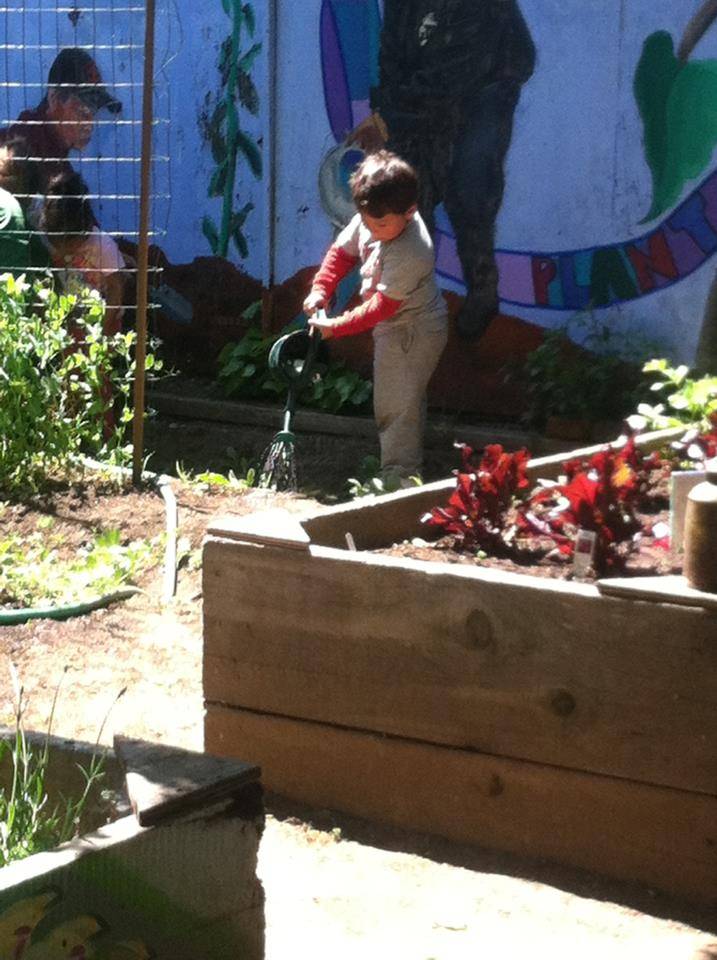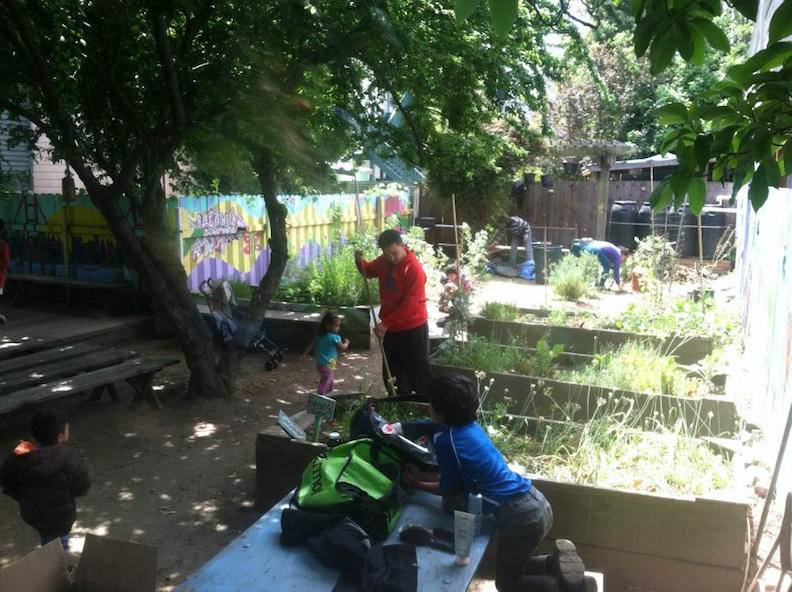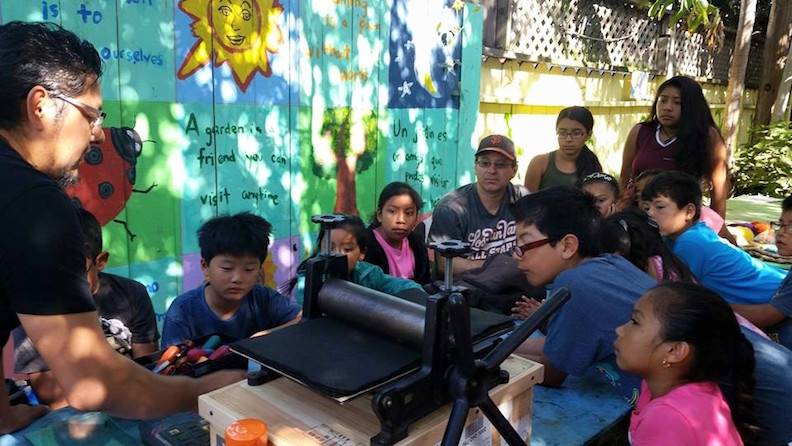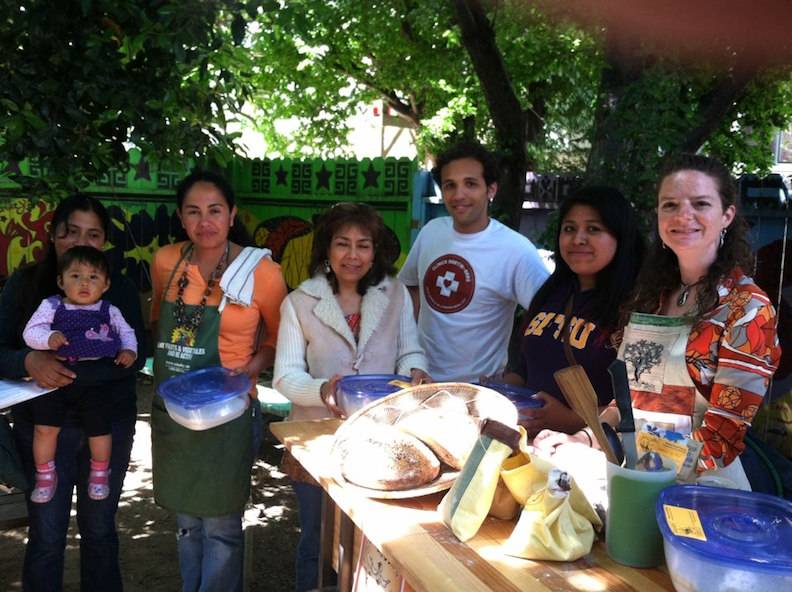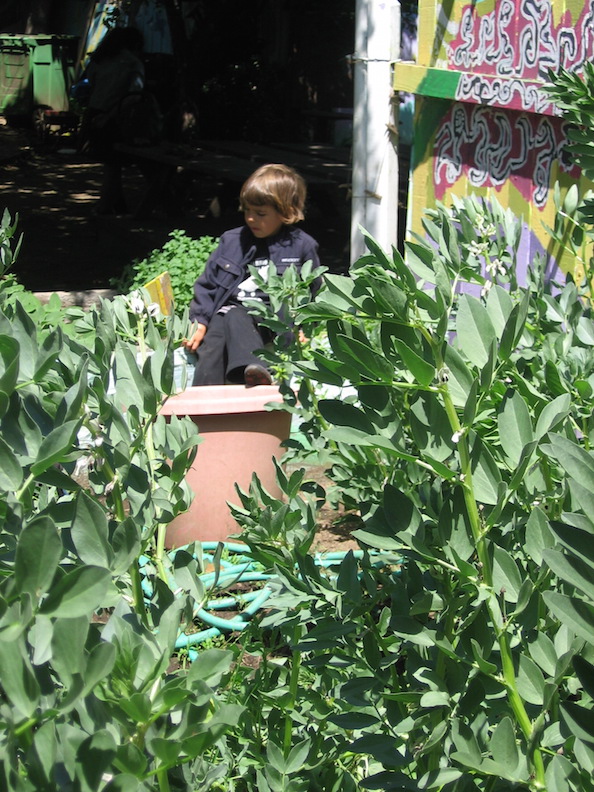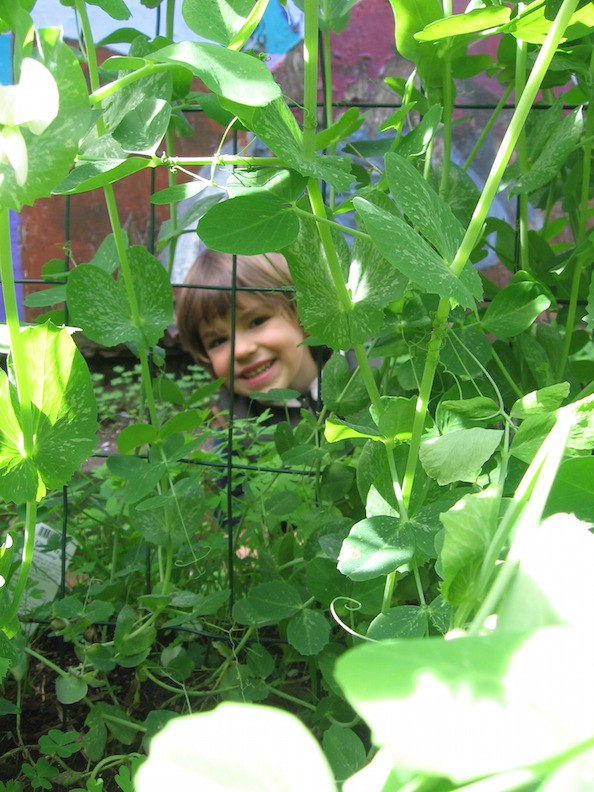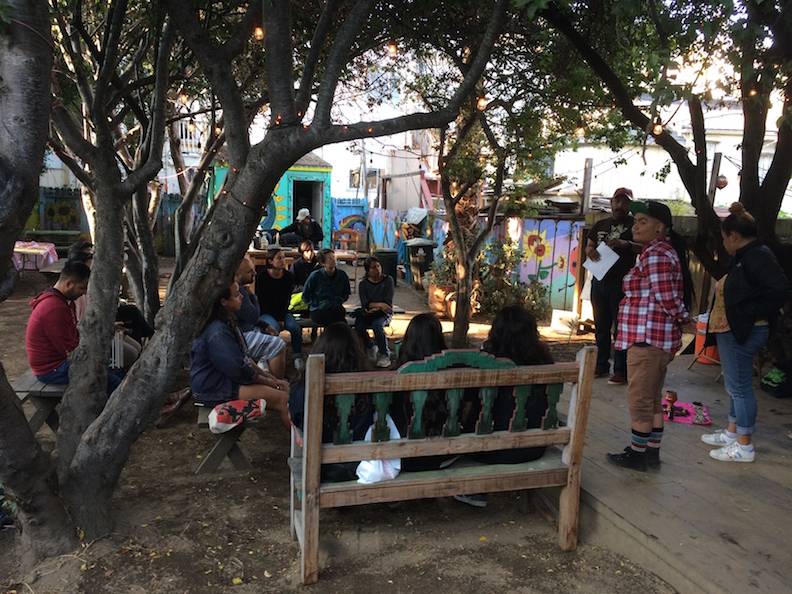El Jardín Secreto
"I was there..."
by Fernando Martí, July 2020
A child waters plants growing at El Jardín Secreto in the Mission District.
Photo: LisaRuth Elliott
In the middle of the Mission District, a straight downhill bike ride from my house at 23rd Street, is a secret garden, “El Jardín Secreto,” hidden behind the old Victorians. It’s a little plot of land, locked behind the other houses except for a narrow five-foot easement from Harrison. Maybe somewhere along the way, some utopian developer imagined a common space or orchard that all the houses on the block could open on to. Maybe it was a mistake of earthquake or fire, when property lines were redrawn and a piece of land later left unclaimed, or left in limbo from some legal squabble. The old Sanborn maps from 1900 show that a two-story house used to sit here, where the plums are now, and another house where the loquat trees are. Maybe it was one of those houses poorer homeowners built first, in the back, waiting for better fortunes to build the real house out front on the street (it’s what my parents did when they moved to the city from their farm in Ecuador).
The land ended up in the tax collector’s hands by the early 1990s. The story goes that it became an abandoned drug house, maybe burned down, became a dumping ground for old refrigerators and washing machines, but my friend Jenny who moved to Harrison Street in the 1990s just remembers an overgrown lot, the neighbor kids playing in it, maybe some Mission teenagers sneaking in to smoke pot.
Tending to the land in this hidden spot.
Photo: Courtesy PODERSF
In the early 1990s, neighbors started an organizing campaign to reclaim the site with a community-based steward. El Tecolote’s archivist Linda Wilson was part of that. Mission Housing had acquired a couple of the apartments on 23rd Street, backing onto the empty lot, then had the city deed the lot to them. My friend Eric Quezada, who ran the resident programs at Mission Housing, dreamed of a space that would serve their tenants and lower income Latinx kids from the Mission without access to gardens or green space. By around 1999, Eric, together with Lilian Boctor, Charlie Sciammas, and community volunteers, had cleaned out the lot, built a stage and a greenhouse and raised beds, and started a summer camp for local kids. In partnership with the Mexican Museum, they hired artists Robert Marosi and Alberto Toscano to develop a free summer arts and environmental stewardship program for neighborhood kids. Mission Housing was the caretaker for many years, engaging residents in their affordable housing buildings with gardening and cultural programming, and other staff members got involved, like Teresa Melendraz and Angela Hodgson and Desiree Almendral.
An evening of music and performance en el Jardín Secreto.
Photo: Courtesy PODERSF
The space not only served kids in the summer, but was opened to all kinds of events that prioritized the working class and immigrant community of the Mission, but it was not a traditional “community garden” with private plots for each of the neighbors. The bi-monthly Mission Arts & Performance Project (MAPP) has almost always had a night of music and poetry at the garden, a magical space for that other, bohemian/revolutionary side of the Mission. There have been talks with farmers from Cuba, vegan cooking classes, fruit canning workshops, and outdoor movie festivals. And of course, growing vegetables and fruits. How much food has been produced over the years, and given away through the Free Farm Stand at the park around the corner?
As the Day of the Dead festival on Garfield Park became bigger and bigger, becoming a Bay Area attraction, Mission Housing began organizing their own family-oriented Día de los Muertos, with the participation of kids from Leonard Flynn and Cesar Chavez elementary schools, to remember those who have passed on in a reenactment of a ritual celebration that’s been going on for thousands of years in the Americas. The children run around under the trees and visit the altars, drinking hot atole, while we celebrate the souls who have given so much to the garden with their voices and art and work: Eric and Alberto, taken by cancer way too young, and Mamacoatl and Alfonso Texidor and others. How many have enriched this space with their souls, how many souls live on in this space?
The garden has evolved over the years. I remember Robert inviting me to help with the kids’ mural in 2003, and repainting it with him and a different round of kids fifteen years later. There’s an evolution there, a story painted in every surface of fence and shed and neighboring wall, as Robert leads the kids year after year in mural projects.
Jose Cruz with students learning the art of screenprinting.
Photo: Monica Alfaro
After 2005, when Mission Housing imploded in a struggle between staff and board, and almost the entire staff left, care of the garden was transferred to PODER, and Good Samaritan picked up the summer camp program. Tere Almaguer from PODER has coordinated the annual Día de los Muertos and the many events and classes, and managed an on-again, off-again group of volunteer stewards. The land is always there, but every year different people step up to care and feed it—people like Clara Cheeves and Tree and Cristina Ibarra and Sofia Elias and Windsong and Carlos Peterson-Gomez and Martin Herrera and Nancy Hernandez and Edgar Molina and Jenny Friedenbach and Alli Cuentos, and lots of others I’ve never met but who’ve left their spirit here. Chema Hernandez-Gil organized vegan cooking circles, and LisaRuth Elliott taught breadbaking workshops with Clínica Martin Baro, and one day artist Jose Cruz hauled out his printing press and carving tools to teach the kids printmaking.
LisaRuth Elliott's Bread-u-cation workshop for patients of the Clínica Martín-Baró, May 2013.
Photo: Courtesy LisaRuth's Lovin' From the Oven
Cooking demonstration
Photo: Fernando Martí
I think around 2010 a big garden shed was installed, and a concrete counter with sink and grill, and cooking classes took off. In 2014, Movement Generation’s Permaculture for the People crew installed a rain barrel system, picking up the water from the neighbor’s shed that backed onto the garden. The construction training program from Asian Neighborhood Design came to build new benches and raised beds, and one of the young women in the program suddenly remembered the place where she had spent a summer in camp. How many children have grown up in the Mission with the Secret Garden as a part of their lives?
On a rope swing under the plum tree.
Photo: Fernando Martí
There are all sorts of beautiful stairways and gardens in San Francisco, and there are school gardens, some more wild and others carefully laid out in rows of steel containers, but there are few magical places like this that belong to the community, where a Mission District kid, maybe growing up in a crowded apartment with no outdoor space, for whom the outdoors and farming has been no more than a reference in their parents’ stories and memories, can spend every day of his or her summer swinging on the rope swing under the plum tree, collecting tart cherry plums or sweet loquats or digging up the dirt or watering the plants or performing a play on an outdoor stage.
But this summer, the summer of the pandemic, will be much smaller, and very short, just the last few weeks of summer, if it happens at all. This’ll be the first summer in a few years that I haven’t spent my Thursdays off work with the kids, making leaf prints or screenprinting t-shirts or painting a new mural or reading nature stories from the stage.
Ironically, this is the year I’ve spent the most time in the garden. I felt lucky, privileged, to be able to do this work this year to help prepare the land for the summer kids, and now, maybe, they won’t come. I was planning on getting the kids to ask their parents about the herbs they remember from home, making smudge bundles from white sage and rosemary and lavender, and drying cooking herbs from the garden for the kids to take home. Since February, when I had taken a sabbatical from work, I’ve been visiting the garden a couple of times a week, weeding and pruning and planting and watering, and in between visits, I could see that others had come by too, never sure who. The sabbatical was to be my time to work on art and the soil, before the pandemic and shelter-in-place took over our lives, but I guess I’m now there with the spirit of these strange times, all sorts of people unexpectedly remembering to turn back to what’s important in the face of disease and uncertainty, to remind ourselves that nature works with us when we work with her.
The colors of the (tools of the) garden.
Photo: Fernando Martí
In January it rains till the middle of the month. I make my first visit since Día de los Muertos just after Candelaria in early February, season of sweeping and lighting candles and opening windows. There’s oxalis everywhere, and nasturtiums and fennel. A blue jay wonders what I’m doing in the garden. The camelias along the front entrance open their buds, reminding me of my auntie’s house in San Gabriel. I meet up with Sofia and Carlos, and pull the nasturtiums that have taken over the raised boxes, and the oxalis with its brilliant yellow flowers covering the garden field. It’s the first February in 100 years that it hasn’t rained in the Bay Area. Showers come back the first week of March, and the jasmine goes wild. Last year’s kale is covered in aphids, and I bring ladybugs from a box bought at the garden store. Carmelo and his friend dig up skinks from under the logs of the neighbor’s old cedar that fell over the fence last year. Mushrooms come up too, and I wish I knew more about mushrooms. The last real rains of the year end the first week of April. The thistles and sowthistles come up, I pull them mercilessly, and they attack back stinging the exposed skin above the gloves. I should find a good place for protective thistles, away from where young children will play. I bring a box of redworms for the little worm box, and I feed them carefully. The jasmine flowers begin to dry up – strange, because in front of other houses they seem to be going strong. But the plum trees blossom, and I think of flower festivals in Japan, shouldn’t we have one here, and didn’t the Aztecs have rain festivals and flower festivals this time of year? In May the ground is covered in little white plum blossoms. Now bindweed is my new enemy, curling around the other plants, pulling them down, and extending everywhere with their long trailing white roots. It’s an impressive weed. In June the compost worms all disappear mysteriously, and I don’t know if I gave them too much brown or too much green or it wasn’t moist enough or it was too moist, or they simply decided there was a whole garden to explore and they didn’t want to be stuck in a black plastic container. Among the bindweed tangles, a sunflower appears (I’ve been watering and weeding for an hour before I see it staring at me), and amaranth pops up everywhere, and what I think is yarrow, before Alondra corrects me that it’s poison hemlock.
This is the biggest year for plums in a long time. Jacqui reminds me how they just want to give, but they need a chill time, a time to rest. During the drought a few years back, that was the year for resting, so that now they can give back. We all need to rest and heal, especially now. In this windswept city, with stunted street trees, the dappled light under the plums are a place of magic. One of the trees in particular—maybe that’s the mother of the others, and there’s probably more than one placenta buried under it. There are two smaller plums framing the entrance now, and Jenny says they just appeared, as children left their plum pits on their way out, and are now starting to fruit.
There is a family of opossums that live under the neighbor’s deck, and make their way under fences to Sofia’s yard several houses down, and robins that pull fiber from the old palm tree for their nests, and blue jays that come hunting for whatever scraps the children have left behind, and hummingbirds and bees that come to circle the purple flowers of the bee balm bushes.
Carmelo among the fava beans.
Photo: Fernando Martí
I plant corn and beans (actually, snap peas, because the kids might be able to eat them right off the vine) and potatoes, the staples that have sustained native people of North and South America for millennia. Squash is still missing, I have to find a place for that. Tere brings tomatoes from Hummingbird Farm, another American food, the smell of their leaves reminding me of wandering through the back lands of my family’s plot in Ecuador, finding wild cherry tomatoes in the sunny spots between cacao and mango stands, protected by giant long-legged translucent blue spiders. I bring strawberries, maybe not the best for foggy San Francisco, but I know the kids love them. Every week I pinch off the early blossoms, until June, waiting for the roots to grow strong. Later Tere brings white sage and tobacco to plant as well, sacred plants. When the sage that was already in the garden blooms and the long spindly arms start to break, I collect them for bundles, tie them with hemp twine and take them to the PODER crew running our Thursday food drops for families struggling during the pandemic.
Carmelo peeking out from behind plants in a raised bed.
Photo: Fernando Martí
Sometimes, before starting a day of zoom calls, Michelle and I ride our bikes down the hill to water the plants. On a hot July Fourth, we meet up with Sofia and Evelyn to prune the tomatoes and cut back the herbs and take stock of the garden for what we hope will be a summer program running wild with kids who’ve been cooped up too long in their houses and on their screens. Carmelo climbs the plum trees as he’s been doing here since he was two, and tosses ripe plums down to his friend Amaru, and we amass a huge bucket of cherry plums and nísperos (Japanese plums or loquats) for Sofia to take to the Free Farm Stand on Sunday.
After they tested the soil around 2014, PODER changed out all the old pressure-treated planters for new redwood and clean soil. They sheet-mulched the open “meadow” and brought in new soil and mulched and wintered it with nitrogen fixers. Dandelions come back in the spring, their long roots reaching down, down, under the layers of new soil and mulches and lead particles and maybe compacted gravel from under old abandoned foundations, down to the original soils, marsh sediments or creek beds.
I think of what the land of this garden was before all the concrete and fences and dilapidated back sheds surrounding it, before Victorian cottages and apartment buildings, before property lines all in a row, every 25 feet or 30 feet. Before Mission plank roads and cows trampling over native grasses and shitting on the narrow pristine creeks. Before missionaries and disease and robbing people of their land and language and lifeways.
A gathering at El Jardín Secreto.
Photo: Fernando Martí
What hands tended the grasses that grew here, collected seed for pinole? What name did they give this little corner, where were the footpaths, what tree marked this spot, where were the hidden spirit places that had to be thanked? These were Ramaytush Ohlone people, California acorn people, but here, in Yelamu, the windy, sand-blown north end of the peninsula dotted with scrub oaks, grass seeds, and roots and berries were probably as important, along with insects, fish, and fowl from the Bay. We, guests on this land, don’t have that same connection to seed, to burden baskets and beater fans and clapper sticks, to burning fields so the grasses and reeds will come back stronger next year, to knowing the names of each footpath and seed meadow and creek. To the spirits.
North of here, along Harrison, the land became marshier, source of willow and reeds for basketmaking, feeding into Mission Creek (now buried under Division Street and the Central Freeway) and down to the Bay. Footpaths led to a village, Chutchui, up near 16th Street, and down to another camp, Sitlintac, near the wetlands of Mission Bay. More paths led south, to Precita Creek (now buried under Cesar Chavez). The earliest settler maps show a crooked street called Serpentine between 26th and what was then Army Street that seemed to have survived into the 1930s (that little crooked corner of Capp and Mission is its only remnant), and I imagine it might have been what was left of the old Ohlone path, maybe walked on for thousands of years, that followed Precita Creek down to where it met Islais and opened onto the Bay.
The dandelion reaches down, bringing up through its deep roots all that medicine of history. What will we, not native to this place, do with all this medicine?

